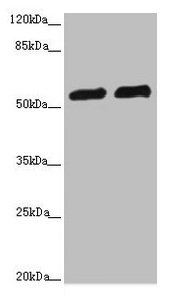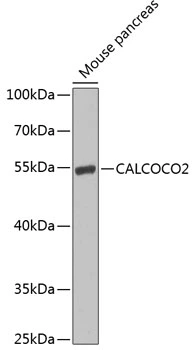NDP52 antibody
GTX115378
ApplicationsImmunoFluorescence, ImmunoPrecipitation, Western Blot, ImmunoCytoChemistry, ImmunoHistoChemistry, ImmunoHistoChemistry Paraffin
Product group Antibodies
ReactivityHuman
TargetCALCOCO2
Overview
- SupplierGeneTex
- Product NameNDP52 antibody
- Delivery Days Customer9
- Application Supplier NoteWB: 1:500-1:10000. ICC/IF: 1:100-1:1000. IHC-P: 1:100-1:1000. IP: 1:100-1:500. *Optimal dilutions/concentrations should be determined by the researcher.Not tested in other applications.
- ApplicationsImmunoFluorescence, ImmunoPrecipitation, Western Blot, ImmunoCytoChemistry, ImmunoHistoChemistry, ImmunoHistoChemistry Paraffin
- CertificationResearch Use Only
- ClonalityPolyclonal
- Concentration1.57 mg/ml
- ConjugateUnconjugated
- Gene ID10241
- Target nameCALCOCO2
- Target descriptioncalcium binding and coiled-coil domain 2
- Target synonymsNDP52, calcium-binding and coiled-coil domain-containing protein 2, antigen nuclear dot 52 kDa protein, nuclear domain 10 protein 52, nuclear domain 10 protein NDP52, nuclear dot protein 52
- HostRabbit
- IsotypeIgG
- Protein IDQ13137
- Protein NameCalcium-binding and coiled-coil domain-containing protein 2
- Scientific DescriptionThe protein encoded by this gene is a subunit of nuclear domain 10 (ND10) bodies. ND10 bodies are nuclear domains appearing immunohistochemically as ten dots per nucleus. They are believed to be associated with the nuclear matrix on the basis of their resistance to nuclease digestion and salt extraction. ND10 proteins are removed from the nucleus by herpes simplex virus-1 infection and may have a role in viral life cycles. [provided by RefSeq]
- ReactivityHuman
- Storage Instruction-20°C or -80°C,2°C to 8°C
- UNSPSC12352203
References
- Dos Santos Á, Rollins DE, Hari-Gupta Y, et al. Autophagy receptor NDP52 alters DNA conformation to modulate RNA polymerase II transcription. Nat Commun. 2023,14(1):2855. doi: 10.1038/s41467-023-38572-9Read this paper
- Ke PY, Chang CW, Hsiao YC. Baicalein Activates Parkin-Dependent Mitophagy through NDP52 and OPTN. Cells. 2022,11(7). doi: 10.3390/cells11071132Read this paper
- Fukushima S, Shimohata T, Inoue Y, et al. Recruitment of LC3 by Campylobacter jejuni to Bacterial Invasion Site on Host Cells via the Rac1-Mediated Signaling Pathway. Front Cell Infect Microbiol. 2022,12:829682. doi: 10.3389/fcimb.2022.829682Read this paper
- Hall BS, Dos Santos SJ, Hsieh LT, et al. Inhibition of the SEC61 translocon by mycolactone induces a protective autophagic response controlled by EIF2S1-dependent translation that does not require ULK1 activity. Autophagy. 2022,18(4):841-859. doi: 10.1080/15548627.2021.1961067Read this paper
- Hung CM, Lombardo PS, Malik N, et al. AMPK/ULK1-mediated phosphorylation of Parkin ACT domain mediates an early step in mitophagy. Sci Adv. 2021,7(15). doi: 10.1126/sciadv.abg4544Read this paper
- Robichaud S, Fairman G, Vijithakumar V, et al. Identification of novel lipid droplet factors that regulate lipophagy and cholesterol efflux in macrophage foam cells. Autophagy. 2021,17(11):3671-3689. doi: 10.1080/15548627.2021.1886839Read this paper
- Wang X, Feng L, Xin M, et al. Mechanisms underlying astrocytic connexin-43 autophagy degradation during cerebral ischemia injury and the effect on neuroinflammation and cell apoptosis. Biomed Pharmacother. 2020,127:110125. doi: 10.1016/j.biopha.2020.110125Read this paper
- Ogawa M, Takada N, Shizukuishi S, et al. Streptococcus pneumoniae triggers hierarchical autophagy through reprogramming of LAPosome-like vesicles via NDP52-delocalization. Commun Biol. 2020,3(1):25. doi: 10.1038/s42003-020-0753-3Read this paper
- Zachari M, Gudmundsson SR, Li Z, et al. Selective Autophagy of Mitochondria on a Ubiquitin-Endoplasmic-Reticulum Platform. Dev Cell. 2019,50(5):627-643.e5. doi: 10.1016/j.devcel.2019.06.016Read this paper
- Liao CC, Ho MY, Liang SM, et al. Autophagic degradation of SQSTM1 inhibits ovarian cancer motility by decreasing DICER1 and AGO2 to induce MIRLET7A-3P. Autophagy. 2018,14(12):2065-2082. doi: 10.1080/15548627.2018.1501135Read this paper

![FACS analysis of MCF7 cells using GTX04863 NDP52 antibody [9E2F2]. Blue line : Primary antibody Green line : Isotype control Red line : Unlabelled sample Dilution : 1microg/1x10? cells](https://www.genetex.com/upload/website/prouct_img/normal/GTX04863/GTX04863_20240531_FACS_24053100_340.webp)


